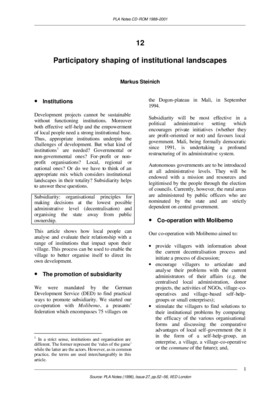PLA Notes CD-ROM 1988-2001 12 Participatory shaping of institutional landscapes

Document begins: PLA Notes CD-ROM 19882001 12 Participatory shaping of institutional landscapes Markus Steinich Institutions the Dogon-plateau in Mali, in September 1994. Development projects cannot be sustainable without functioning institutions. Moreover Subsidiarity will be most effective in a political administrative setting which both effective self-help and the empowerment encourages private initiatives (whether they of local people need a strong institutional base. are profit-oriented or not) and favours local Thus, appropriate institutions underpin the challenges of development. But what kind of government. Mali, being formally democratic institutions1 are needed? Governmental or since 1991, is undertaking a profound non-governmental ones? For-profit or non- restructuring of its administrative system. profit organisations? Local, regional or Autonomous governments are to be introduced national ones? Or do we have to think of an at all administrative levels. They will be appropriate mix which considers institutional endowed with a mission and resources and landscapes in their totality? Subsidiarity helps to answer these questions. legitimised by the people through the election of councils. Currently, however, the rural areas Subsidiarity: organisational principles for are administered by public officers who are making decisions at the lowest possible nominated by the state and are strictly administrative level (decentralisation) and dependent on ...
Cite this publication
Available at https://www.iied.org/g01659